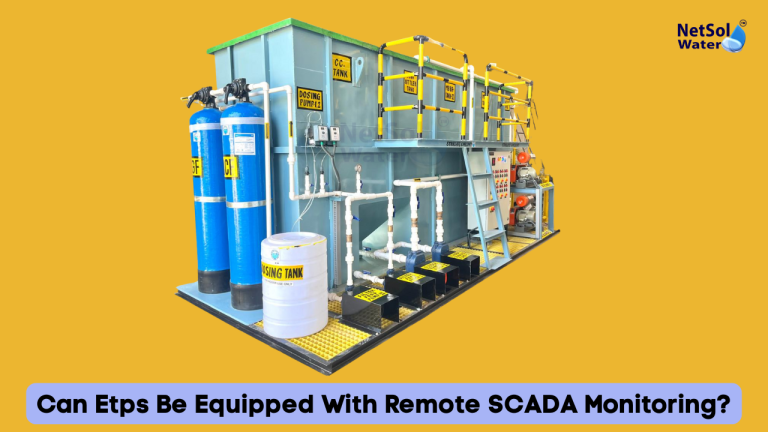
Effluent Treatment Plants are a key feature of contemporary industrial setup. With growing industries and tightening environmental regulations, efficient handling of wastewater treatment is no more a choice, but an absolute necessity. Improving operational efficiency and minimizing human errors is perhaps the most effective method to be followed. Among various automation tools used in the present day, SCADA systems have become the center of attraction. But the question remains—can ETPs be equipped with remote SCADA monitoring? The answer is a definite yes.
What is SCADA and How Does It Work?
SCADA is a centrally located system where operators can observe, operate, and analyze plant performance using sensors, data loggers, controllers, and communications. SCADA gathers real-time information from other parts of the plant and displays it on a computerized interface that can be accessed locally or remotely.
When Effluent Treatment Plant are equipped with remote SCADA monitoring, every process in the plant—such as chemical dosing, pH adjustment, pump operation, flow rate, and sludge management—can be monitored and controlled remotely through a computer, tablet, or smartphone. Such access reduces physical presence and manual control to a large extent, especially for huge industrial complexes or plants in distant areas.
Benefits of ETPs With Remote SCADA Monitoring
1) Alerts and Monitoring in Real Time
Remote SCADA enables operators to track ETP performance in real time. Parameters such as water flow, pH, chemical consumption, and sludge quantity are continuously monitored. If any parameter falls outside the permissible range, an alert is automatically generated to the operator. This enables prompt action and avoids potential harm or non-compliance.
2) Improved Compliance and Reporting
Most industries are obliged to report data and performance to environmental agencies. ETPs with remote SCADA monitoring can automatically generate logs and reports with precision. It guarantees precise documentation and facilitates transparency and compliance.
3) Lower Manpower and Operation Costs
With computerized monitoring and control, less staff need to be on-site. Problems can be tackled or passed on through cell-phone alerts, cutting downtime and operational expenses. Maintenance schedules can also be planned more effectively based on system information, not conjecture.
4) Data Analysis and Optimization
SCADA systems capture and store historic data, which can be employed to identify trends, forecast failures, and enhance the treatment process. For instance, if the chemical usage trend indicates overconsumption at specific hours of the day, the operators can reconfigure the system to make automatic dosage adjustments.
Key Features in SCADA for ETPs
When ETPs are integrated with remote SCADA monitoring, the following features are usually included
1) Remote Dashboard Access: Display plant status and control panels from internet-enabled devices.
2) Alarm Management: Predefine alarm conditions and receive notifications via SMS, email, or applications.
3) Automated Reports: Generate and share daily, weekly, and monthly reports.
4) Secure Login and User Roles: Authorized users alone can view or control the system, ensuring security.
5) Data Backup and Redundancy: Cloud or local backup systems ensure data integrity during network disruptions.
Appropriate Industries and Applications
Remote SCADA monitoring is useful for any sector where wastewater must be treated regularly and safely. Typical industries that can gain from it are:
- Pharmaceuticals
- Food processing
- Textiles
- Chemicals
- Automotive
- Large residential complexes or commercial establishments
In all these instances, the presence of ETP with remote SCADA monitoring means that even in unmanned scenarios, the plant operates efficiently and safely.
Challenges and Considerations
Though the advantages are considerable, there are also some challenges to take into account:
1) Initial Investment: SCADA system installation requires initial investment in the form of sensors, controllers, and licenses of the software.
2) Internet Connectivity: Reliable internet for remote access is critical. Very remote plants might have problems.
3) Cybersecurity: With access to the plant becoming possible through networks, good security measures must be implemented to avoid unauthorized access.
These problems can be easily addressed with proper planning, thus making the integration a good decision in the long run.
Future of Wastewater Management with SCADA
The days of wastewater treatment lie in the future with increasing digitization. Combining IoT (Internet of Things) with SCADA, cloud computing, and AI is bound to introduce smarter decision-making in the operation of plants. ETPs equipped with remote SCADA monitoring are only the initial steps of this digital revolution.
Conclusion
In the present era, the requirement for effective, compliant, and economical wastewater treatment is greater than ever. Monitoring and controlling ETPs remotely gives significant benefits. With enhanced data, superior control, and faster response rates, ETPs equipped with remote SCADA monitoring offer a smart solution for industries of all types. For compliance, cost reduction, or sustainability, SCADA has an important place in contemporary wastewater management.
So, in case you are preparing to upgrade or install your effluent treatment system, think about the worth of ETPs with remote SCADA monitoring—it’s not only a wise choice; it’s the future of environmental stewardship.
Do you need an advice or assistance on selecting the best water and waste water treatment unit? We have solutions for all your problems!
Let us know your problem, our experts will make sure that it goes away.
For an assistance or related query,
Call on +91-9650608473
Or write us at enquiry@netsolwater.com
